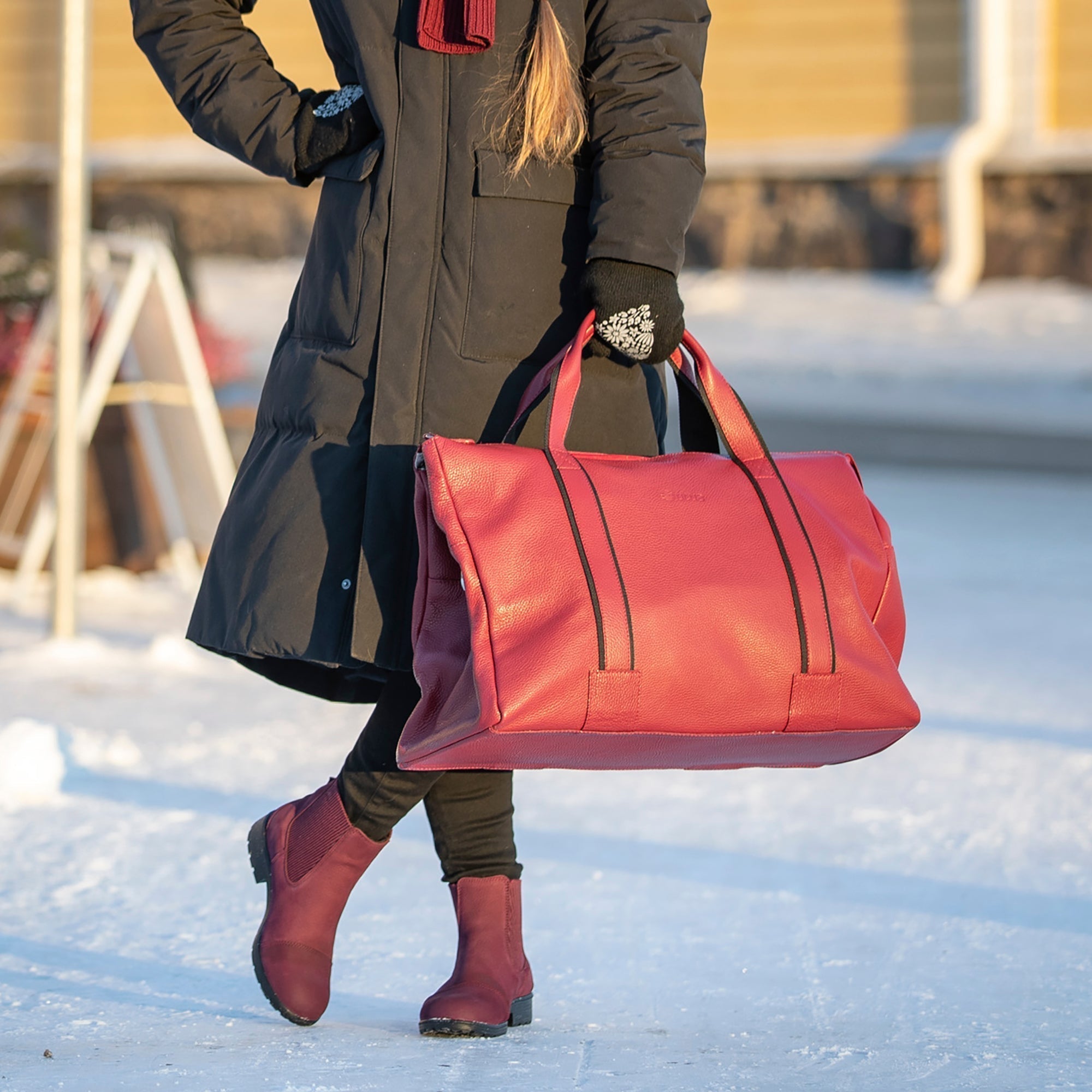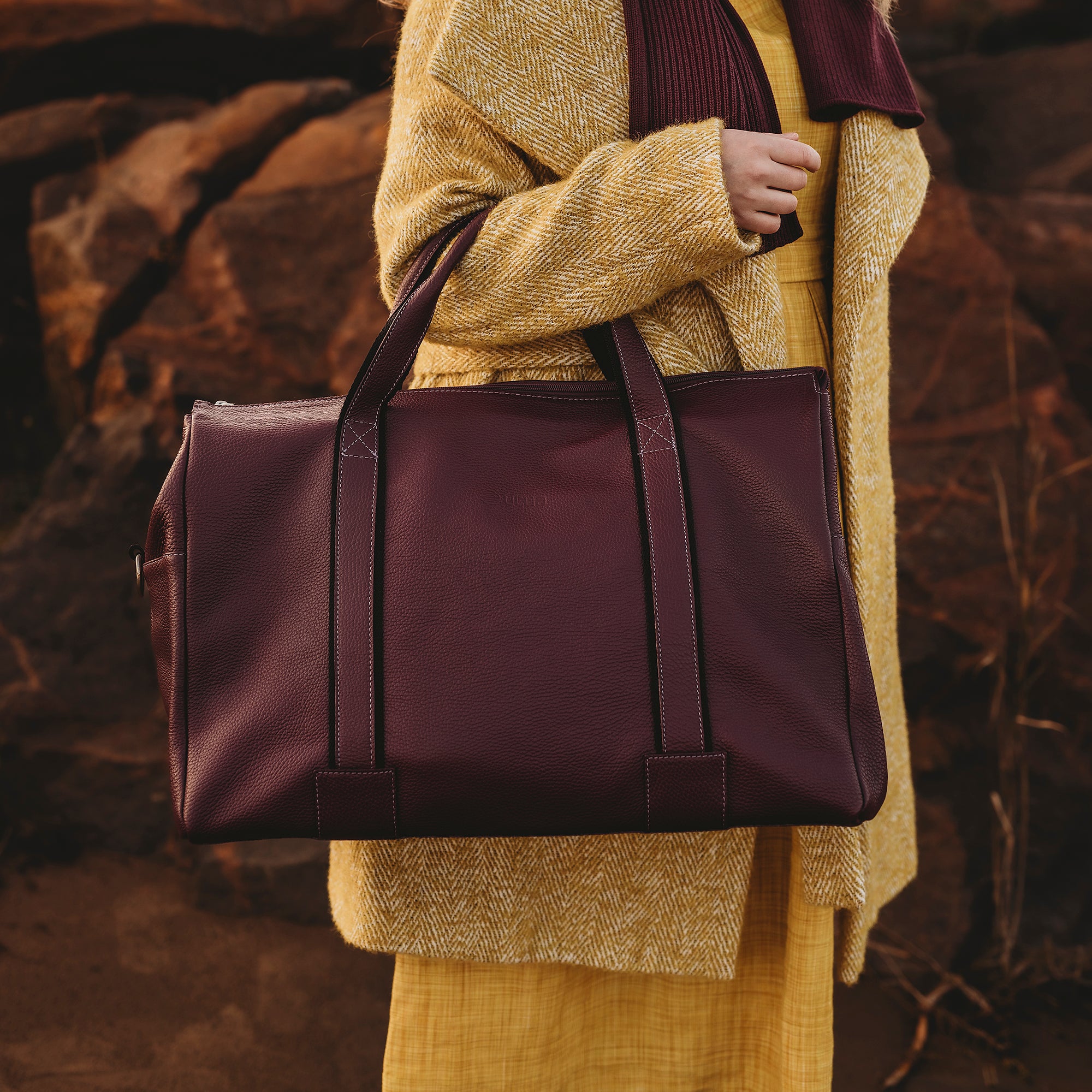
Genuine leather or faux leather: Which do you choose in the bitter cold?
Winter cold can be a challenge for bag materials: should you choose real leather or faux leather? Temperature fluctuations, humidity, and dry indoor air affect the durability and appearance of bags. In particular, there are big differences between real leather and faux leather in how they react to cold weather.
If you're looking for a bag that will last year after year without cracking or losing its shape, it's worth taking a closer look at how different materials behave in the cold. In this blog, we compare the properties of real leather and faux leather, especially in cold weather.
1. How does cold weather affect bags?
Cold air and temperature fluctuations stress bag materials in many ways:
- Moisture: In winter, snow and slush can leave water stains on your bag if the material does not repel water.
- Dryness: Freezing air and indoor heating dry out materials, which can lead to cracking.
- Temperature fluctuations: When you move from cold outside to warm indoors, your bag is exposed to rapid temperature changes, which can affect its flexibility and durability.
Genuine leather and faux leather respond to these challenges in different ways – but which one copes better?

Bag in the picture: Genuine leather Weekender bag in stunning red.
2. How to distinguish between genuine leather and artificial leather?
Before we compare the durability of materials in the cold, it's good to know how to recognize the differences between real leather and faux leather:
- Appearance: Genuine leather patinas, meaning its surface changes naturally over time. Faux leather initially stays the same, but starts to wear and flake.
- Feel: Genuine leather is soft and flexible, while faux leather can feel stiff and plastic.
- Smell: Faux leather can have a chemical smell, while genuine leather has a recognizable, natural scent.
- Breathability: Genuine leather allows air to pass through, making it more comfortable to wear in different weather conditions. Faux leather does not breathe, which can make it cold and stiff in freezing temperatures.
IMITATION LEATHER
Resistance to extreme temperatures:
Faux leather can suffer from extreme temperatures, especially cold, causing it to become stiff and brittle. This can lead to cracking and breaking of the material over time.
Ease of maintenance:
Faux leather is generally an easy-care material that doesn't require as much maintenance as genuine leather. It is often dirt-repellent and can be cleaned with a damp cloth.
Environmental impacts:
The manufacturing process for faux leather can involve harmful chemicals. Faux leather also doesn’t last as long as real leather, resulting in more waste in the long run. It has a larger carbon footprint because the material isn’t as durable as a real leather product.
Price:
Faux leather bags are often more affordable than genuine leather alternatives, making them an attractive choice for budget-conscious consumers. The affordable price is most often explained by mass production in low-cost importing countries and the quality of the material.
How does artificial leather behave in the cold?
Faux leather is often made from synthetic materials such as polyurethane or PVC. These plastic-based materials do not react well to cold:
- Faux leather hardens in the cold. The cold makes the synthetic material less flexible, which can cause it to crack and break.
- Temperature fluctuations can cause the surface to become brittle. When a faux leather bag goes from cold to warm quickly, its surface may start to peel.
- Moisture can damage faux leather. Faux leather doesn't absorb water in the same way as real leather, but when it cracks, it can let moisture in and damage it more quickly.
GENUINE LEATHER
Durability and temperature tolerance:
Genuine leather is a naturally more durable material that will last for years with proper care. It is highly resistant to both cold and moisture, making it a good choice for winter use. Genuine leather also ages beautifully, developing a patina with use.
Thermal insulation:
Leather is a natural material with good thermal insulation properties. This means that it offers better protection against the cold than synthetic leather, which is often thinner and less insulating. For example, if you have cosmetics in your bag, they will stay warmer longer when you go from inside to outside in the cold.
Maintenance:
Genuine leather requires regular maintenance to stay in good condition, especially in winter when the cold and humidity can be challenging. Leather should be treated with moisture protection products and kept clean and dry. But it is not rocket science. For example, treatment with Collonil cleaning and conditioning products is only needed 1-2 times a year. Read the leather bag care instructions on our website.

Bag in the picture: grey Kajo shoulder bag
3. Why is genuine leather better in freezing temperatures?
Genuine leather is one of the few materials that lasts over time and gets better with use. Its advantages in winter use are particularly highlighted in the following areas:
- Temperature resistance: Genuine leather maintains its flexibility in the cold. It does not harden or become brittle in the cold like artificial leather.
- Moisture resistance: Leather is naturally water-repellent, and with proper care it can withstand moisture well.
- Durability: Genuine leather does not crack in the cold, but retains its structure year after year.
4. How should you care for genuine leather in winter?
To keep your leather bag in good condition during the winter, it is worth following a few basic care instructions:
- Protect from moisture: Use a leather protectant to help repel moisture and dirt.
- Clean regularly: Wipe away dirt and salt residue with a damp microfiber cloth.
- Store correctly: Do not leave the bag in a cold car for a long time, and avoid placing it near a radiator indoors.
Regular care in winter conditions will help ensure that your leather bag remains in good condition year after year.
5. Is artificial leather a more ecological choice?
Faux leather or vegan leather is sometimes perceived as a more environmentally friendly option, but its ecological compatibility should be critically examined:
- The manufacturing process of faux leather and vegan leather often uses harmful chemicals and plastics. Vegan leather is also made from plant-based raw materials, such as pineapple fiber and cork.
- Faux leather doesn't last long, which increases waste. Genuine leather lasts for decades.
- Genuine leather is a responsible choice if it is produced ethically. Utua bags are made from leather that is a by-product of food production, meaning we are part of a circular economy.
A long-lasting product is often a more environmentally sustainable choice than a quickly degradable synthetic material.
6. Is it worth investing in a genuine leather bag?
When choosing a bag that will also be used in winter, you should consider the following things:
- Longer lifespan: Genuine leather lasts over time and develops a beautiful patina, while faux leather often starts to wear out and crack within a few years.
- Better comfort: Genuine leather feels comfortable in all temperatures, while synthetic leather can be cold and stiff in freezing temperatures.
- Environmental impact: A long-lasting product is a more responsible choice than a short-lived synthetic bag.
Utua's genuine leather bags are manufactured within the EU in accordance with the principles of sustainable development. Each bag is designed to last over time, both in appearance and structure. Work bags in particular are put to the test year-round. Read our other blog : How to recognize genuine leather?
Finally – choose frost-resistant genuine leather
When choosing a bag for winter use, it's important to consider your personal needs and values. Genuine leather offers durability and quality, but requires more maintenance and is more expensive. Faux leather is more affordable and easy to care for, but doesn't perform as well in the cold and, as a plastic-based material, is not as environmentally responsible.
Utua's genuine leather bag is an ethical and sustainable choice. Our leather products are made from leather that is a by-product of food production and would otherwise go to waste. Our production processes also all take place within the EU, so our transport distances are shorter.
So choose responsible genuine leather instead of faux leather.



